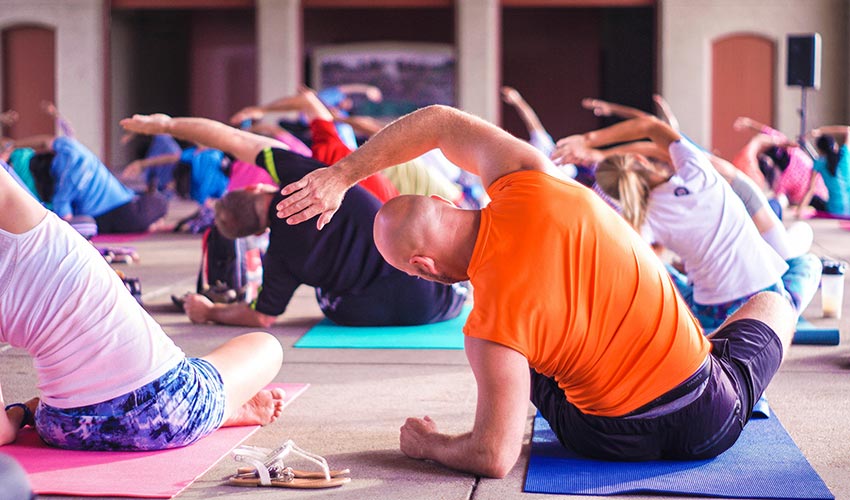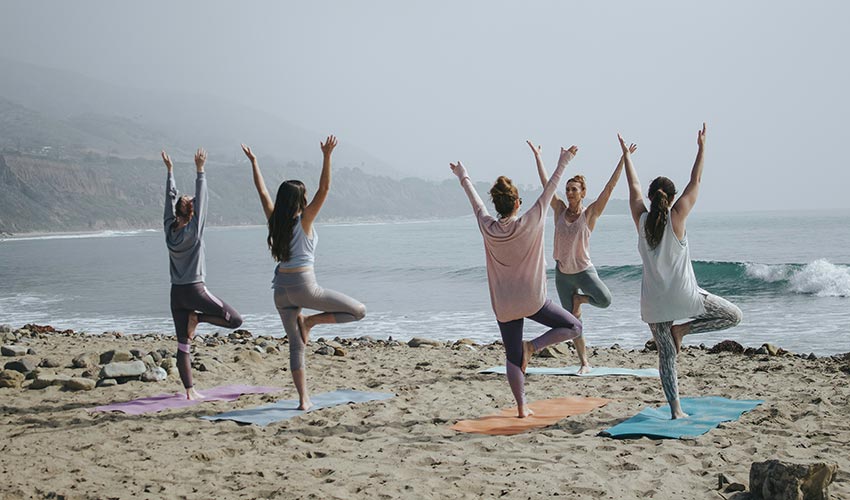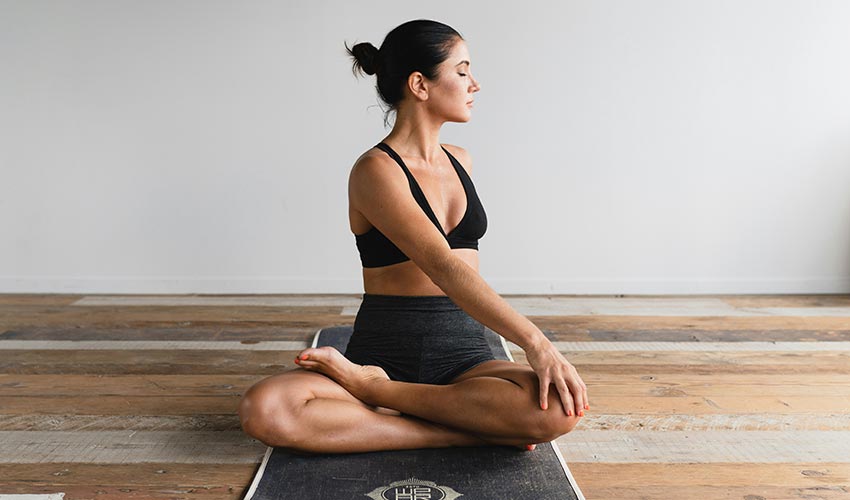Yoga – Ascension in Bodywork
Just like myself, many are seeking ways to reclaim balance and well-being in their lives. One such avenue is the ancient practice of Yoga, a holistic discipline that has been celebrated for thousands of years for its myriad benefits to both body and mind. The yogic path, rooted in Indian philosophy and spirituality, offers more than just physical exercise and stretching; it is a journey toward inner peace, improved health, and heightened awareness; who knew right!?
Yoga hasn’t been the most consistent of endeavours for me. I have however always found myself gravitating back to it, even just for 5-10 minutes at the end of a work out or at the end of the day. I find the breathing focus in Yoga extremely helpful. It sounds ridiculous but it actually reminds me to, breathe! – and to deep belly breathe which is a lot better for our body too (I’ll explain more of why this is further along). I have definitely found myself gravitating often back to Yoga and incorporating it into my days, as and when I need to. It’s such a graceful and beautiful practice where I’ve learned a lot more than just how to ‘stretch’. So let’s get into my own and others' interpretation of Yoga, the different types of Yoga and explore its origins and essence.

The Essence of Yoga
Yoga, derived from the Sanskrit word "yuj," means to unite or yoke. It signifies the union of the individual consciousness with the universal consciousness, leading to a harmony between the mind, body, and spirit. The practice of Yoga encompasses various techniques including asanas (physical postures), pranayama (breathing exercises), meditation, and ethical disciplines. I find that Yoga has helped me to get to know my body as it has enabled me to slow down and become conscious of the movement I’m doing and how it feels in my body. Learning more about Yoga also has really developed my relationship with it as an art form, as expression through movement. Let’s take a look at the Eight Limbs of Yoga in particular, outlined by the sage Patanjali in the Yoga Sutras:
The Eight Limbs of Yoga
The eight limbs of Yoga provide a comprehensive guide to living a meaningful and purposeful life. Sage Patanjali describes this eight-fold path as “ashtanga Yoga” in sutra 29 (aphorism 2.29), a different style of Yoga which is slightly more fast paced and follows certain movements. He created this path to help us transcend human suffering and to establish self-realisation and ultimately, freedom:
Yamas: Ethical standards and moral conduct.
Niyamas: Self-discipline and spiritual observances.
Asanas: Physical postures designed to keep the body strong, flexible, and healthy.
Pranayama: Breath control, enhancing respiratory function and energy flow.
Pratyahara: Withdrawal of the senses, directing the focus inward.
Dharana: Concentration and cultivating inner perceptual awareness.
Dhyana: Meditation, leading to a profound state of inner peace.
Samadhi: A state of ecstasy and union with the divine.
This particular precious philosophy stuck out for me personally as it’s directly connected to transformation through this very accessible act of movement, and how we can promote a harmonious link with mind, body and spirit through these practices. There are quite a few different practices of Yoga which can be confusing and like most things, overwhelming when you’re starting to look into it, however the best advice I can give here is to not look at too much, to learn the basics first, and then discover the history of Yoga through ancient texts such as The Bhagavad Gita and Patanjali’s Yoga Sutras. But first and foremost, get moving your body and understanding your breathing patterns during that movement, then you can feel into which pathways of Yoga resonate as you begin to take your practice to the next level.

The Different Types of Yoga
Yoga encompasses a wide range of practices, each with its own unique focus and benefits. When I first came to Yoga many years ago, I had NO idea the expansiveness of all the different Yoga techniques and just how many ways there was to do this practice, depending on your needs at the time. Some people choose one approach and stick to it, however if you’re anything like me, I like a bit of variety! So let’s have a look at some of the most common types of Yoga:
Hatha Yoga
- Focus: General physical health and well-being.
- Description: Hatha is a broad category that includes most Yoga styles. It typically involves a combination of postures (asanas), breath control (pranayama), and meditation.
Vinyasa Yoga
- Focus: Flow and movement.
- Description: Also known as "flow" Yoga, Vinyasa involves linking breath with movement, creating a dynamic and fluid practice. Each movement is synchronised with a breath.
Ashtanga Yoga
- Focus: Strength, flexibility, and stamina.
- Description: A rigorous and structured practice, Ashtanga consists of a specific sequence of postures performed in the same order. It includes six series of increasing difficulty.
Iyengar Yoga
- Focus: Precision and alignment.
- Description: Developed by B.K.S. Iyengar, this style emphasises proper alignment and uses props such as belts, blocks, and blankets to help students perform poses correctly.
Bikram Yoga
- Focus: Heat and detoxification.
- Description: Bikram Yoga is practiced in a heated room (about 105°F/40°C with 40% humidity) and follows a set sequence of 26 postures and two breathing exercises.
Kundalini Yoga
- Focus: Energy awakening and spiritual growth.
- Description: Kundalini Yoga combines postures, breath work, chanting, and meditation to awaken the kundalini energy coiled at the base of the spine and promote spiritual enlightenment.
Yin Yoga
- Focus: Deep stretching and relaxation.
- Description: Yin Yoga involves holding passive poses for extended periods (typically 3-5 minutes) to target deep connective tissues and increase flexibility.
Restorative Yoga
- Focus: Relaxation and stress relief.
- Description: This gentle practice uses props to support the body in restful poses, promoting deep relaxation and recovery.
Power Yoga
- Focus: Fitness and strength.
- Description: A vigorous and fitness-based approach to vinyasa-style Yoga, power Yoga aims to build strength, stamina, and flexibility.
Sivananda Yoga
- Focus: Holistic health and well-being.
- Description: This traditional style follows a set sequence of 12 basic asanas, sun salutations, breathing exercises, relaxation, and meditation.
Jivamukti Yoga
- Focus: Ethical and spiritual practice.
- Description: Jivamukti combines vigorous vinyasa-style practice with spiritual teachings, chanting, and a strong emphasis on veganism and environmentalism.
Anusara Yoga
- Focus: Alignment and heart-opening.
- Description: A modern style focusing on alignment principles and a philosophy of seeing the good in all beings and things.
Kripalu Yoga
- Focus: Compassion and self-awareness.
- Description: Kripalu encourages self-discovery and transformation through postures, breath work, and meditation, with an emphasis on listening to your body's needs.
Vini Yoga
- Focus: Personalised and therapeutic practice.
- Description: Tailored to individual needs, Vini Yoga adapts postures and practices to suit the practitioner's health, capabilities, and goals.
Integral Yoga
- Focus: Integrating mind, body, and spirit.
- Description: This comprehensive practice includes asanas, pranayama, meditation, selfless service, and philosophical study.
Each type of Yoga offers unique benefits and caters to different aspects of physical, mental, and spiritual health. You can choose a style that aligns with your personal goals, preferences and lifestyle. I have personally chosen a mixture of different styles throughout the years depending on where I am at the time. I haven’t limited myself to ONE specific way. It’s been interesting to discover lots of different types of Yoga and to incorporate these together either all at once, or one style each day, depending on my preferences at the time.

The Health Benefits of Yoga
The practice of Yoga is renowned for its extensive health benefits, which span the physical, mental, and emotional realms. It really is such a vast spectrum of healing possibilities with this magical practice. So let’s explore here some of the benefits:
Physical Health
Flexibility & Strength
Regular practice of asanas increases flexibility and strengthens muscles. This not only improves physical performance but also reduces the risk of injuries
Improved Posture
Yoga emphasises body alignment, which enhances posture and alleviates chronic pain, particularly in the back, neck, and joints.
Enhanced Circulation
The combination of movement and breath work improves blood circulation, promoting cardiovascular health.
Boosted Immunity
Certain asanas and pranayama techniques help in detoxifying the body and boosting the immune system, making practitioners less susceptible to illnesses.
Better Digestion
Yoga postures that involve twisting and stretching massage the internal organs, improving digestive health and reducing symptoms of digestive disorders.
Mental Health
Stress Reduction
Yoga reduces the production of cortisol, the stress hormone, and triggers the relaxation response. This helps in managing stress and anxiety effectively.
Enhanced Focus & Clarity
Through practices like pranayama and meditation, Yoga sharpens mental focus and clarity, leading to improved cognitive function.
Emotional Stability
Yoga fosters a sense of inner peace and emotional resilience, helping individuals manage their emotions more effectively.
Emotional & Spiritual Well-being
Self-Awareness
Yoga encourages self-reflection and mindfulness, promoting a deeper understanding of oneself and one's place in the world.
Connection to Self & Others
The practice fosters a sense of connectedness and compassion, enhancing relationships and social interactions.
Spiritual Growth
For many, Yoga is a spiritual practice that deepens their connection to the divine, providing a sense of purpose and fulfilment.

Why Choose Yoga?
The appeal of Yoga lies in its adaptability and inclusivity. Whether you are young or old, fit or seeking fitness, Yoga can be tailored to suit your individual needs and goals. Its holistic approach ensures that it addresses various aspects of health, making it a comprehensive tool for overall well-being.
Accessible to All
Yoga is not just for the flexible or the spiritually inclined; it is a practice that can be adapted to suit all levels of ability and experience. From gentle restorative Yoga to vigorous power Yoga, there is a style that fits every individual's needs.
Mind-Body Connection
Unlike other forms of exercise that may focus solely on physical fitness, Yoga promotes a balanced mind-body connection. This integrated approach ensures that the benefits extend beyond the mat, influencing various aspects of daily life.
Preventive & Therapeutic Benefits
Yoga's emphasis on health and wellness serves as both a preventive measure and a therapeutic intervention. Regular practice can help prevent the onset of various lifestyle-related diseases while also serving as an effective complementary therapy for existing conditions.

Deep Belly Breathing
Deep belly breathing, also known as diaphragmatic breathing, is a powerful technique that can significantly improve overall health and well-being. This form of breathing involves inhaling deeply into the belly, allowing the diaphragm to fully expand and contract. I was told once, it’s exactly like how babies breathe if you watch their bellies rise and fall. Here are several reasons why deep belly breathing is better for overall health:
Enhanced Oxygen Exchange
Deep belly breathing promotes a more efficient exchange of oxygen and carbon dioxide in the lungs. By fully engaging the diaphragm, more air reaches the lower parts of the lungs where blood flow is greatest. This maximizes oxygen uptake and improves the removal of carbon dioxide, leading to better cellular function and increased energy levels.
Reduced Stress & Anxiety
Deep belly breathing activates the parasympathetic nervous system, which is responsible for the "rest and digest" response. This helps counteract the body's stress response, reducing the production of stress hormones like cortisol. As a result, deep breathing can alleviate symptoms of stress and anxiety, promoting a sense of calm and relaxation.
Improved Cardiovascular Health
By lowering stress levels and promoting relaxation, deep belly breathing can have a positive impact on cardiovascular health. It helps reduce blood pressure and heart rate, decreasing the strain on the heart and improving overall cardiovascular function. Regular practice of deep breathing can also enhance heart rate variability, an indicator of a healthy autonomic nervous system.
Enhanced Lung Function
Deep belly breathing strengthens the diaphragm and other respiratory muscles, improving overall lung capacity and function. This can be particularly beneficial for individuals with respiratory conditions such as asthma, chronic obstructive pulmonary disease (COPD), and other breathing difficulties. Improved lung function also enhances endurance and physical performance.
Better Digestion
Engaging in deep belly breathing stimulates the vagus nerve, which plays a crucial role in the parasympathetic nervous system and digestion. This can improve digestive processes by increasing the production of digestive enzymes, promoting peristalsis (the movement of food through the digestive tract), and reducing symptoms of indigestion and bloating.
Pain Management
Deep belly breathing can be an effective tool for managing chronic pain. By promoting relaxation and reducing stress, it can help decrease the perception of pain. Additionally, improved oxygenation and circulation from deep breathing can aid in the healing process and reduce inflammation.
Enhanced Mental Clarity & Focus
Deep breathing increases oxygen supply to the brain, enhancing cognitive function and mental clarity. It also helps reduce mental fatigue and improve concentration, making it easier to stay focused and productive throughout the day.
Improved Posture & Core Stability
Practicing deep belly breathing encourages proper posture by engaging the core muscles, including the diaphragm, abdominal muscles, and lower back muscles. This can help alleviate back pain and improve overall body alignment and stability.
Emotional Regulation
Deep belly breathing can help regulate emotions by providing a simple and effective way to manage emotional responses. By focusing on the breath, individuals can create a sense of mindfulness and presence, which can reduce emotional reactivity and enhance emotional resilience.
Support for Mindfulness & Meditation
Deep belly breathing is a fundamental component of mindfulness and meditation practices. It helps anchor the mind, making it easier to cultivate awareness and presence. Regular practice can lead to greater emotional balance, self-awareness, and a deeper sense of inner peace.
How to Practice Deep Belly Breathing
- Find a Comfortable Position: Sit or lie down in a comfortable position with your back straight and shoulders relaxed.
- Place Your Hands: Place one hand on your chest and the other on your belly.
- Inhale Deeply: Inhale slowly and deeply through your nose, allowing your belly to rise as you fill your lungs with air. Your chest should remain relatively still.
- Exhale Fully: Exhale slowly and completely through your mouth, letting your belly fall as you release the air. Again, your chest should stay relatively still.
- Repeat: Continue this pattern of deep breathing for several minutes, focusing on the rise and fall of your belly with each breath.
Incorporating deep belly breathing into your daily routine can provide profound benefits for your overall health and well-being. By taking the time to breathe deeply and mindfully, you can enhance your physical, mental, and emotional health, leading to a more balanced and fulfilling life.

Michael Singer on ‘Yoga’
Michael Singer, the author of "The Untethered Soul" and "The Surrender Experiment," (two of my most favourite books on planet earth), discusses the significance of Yoga practices in the context of spiritual growth and inner peace. While he may not delve into the physical aspects of Yoga as much as the philosophical and spiritual dimensions, his teachings emphasise the following key points about Yoga practices:
Union with the Self:
Meaning of Yoga:
Singer explains that the word "Yoga" means union, specifically the union of the individual soul with the universal consciousness. Yoga practices are thus aimed at helping individuals connect with their true selves and transcend the ego.
Mindfulness & Presence:
Living in the Present:
Through Yoga practices, individuals learn to quiet the mind and focus on the present moment. This mindfulness helps in reducing mental clutter and achieving a state of inner stillness.
Inner Peace & Surrender:
Letting Go:
Singer emphasises the importance of letting go of attachments and personal preferences. Yoga practices can facilitate this by encouraging us to surrender to the flow of life and accept things as they are.
Meditation & Breathwork:
Deep Meditation:
Singer advocates for meditation as a core component of Yoga. Meditation practices help in observing the mind, detaching from incessant thoughts, and experiencing deeper states of consciousness.
Breath Awareness:
Conscious breathing and pranayama (breath control) are integral to Yoga practices, aiding in calming the mind and energising the body.
Self-Observation:
Witness Consciousness:
One of the central themes in Singer's teachings is the practice of observing oneself. Yoga encourages this self-observation, enabling individuals to become aware of their thoughts, emotions, and reactions without being controlled by them.
Spiritual Growth:
Path to Enlightenment:
Yoga practices are seen as a path to spiritual enlightenment. By consistently engaging in these practices, individuals can gradually dissolve their egoic patterns and realise their true nature.
Holistic Well-being:
Balance and Harmony:
Singer acknowledges that Yoga contributes to overall well-being by balancing the physical, mental, and spiritual aspects of life. This holistic approach leads to a harmonious existence.
Michael Singer views Yoga practices as vital tools for achieving inner peace, spiritual growth, and a deeper connection with the true self. He emphasises the importance of mindfulness, meditation, and self-surrender in the journey towards union with the universal consciousness. There are so many amazing talks you can listen to for free on YouTube of his where he discusses these topics and more. I highly recommend listening to him and contemplating what Yoga can mean, AND do for you.

The Yogic path, which ever type of Yoga you choose, offers a transformative journey toward better health and a more balanced life. Its comprehensive approach addresses physical fitness, mental clarity, and emotional well-being, making it a powerful tool for achieving holistic health. Whether you are seeking to alleviate stress, improve your physical condition, or deepen your spiritual practice, Yoga provides a pathway to a more harmonious and fulfilling life. So why not embrace the yogic path and discover the profound benefits that could be waiting for you on the other side of your Yogic journey.
I will end here with a fantastic quote from Max Strom which I think helps to round up the message this article offers to deliver quite nicely – “The Yoga postures and breath are tools to rebuild and transform ourselves. The goal is not to tie ourselves in knots – we’re already tied in knots. The aim is to untie the knots in our heart. The aim is to unite with the ultimate, loving and peaceful power of the universe”.
“Yoga is an effortless dance with breath and gravity” – Vanda Scaravelli
“Yoga is the journey of the self, through the self, to the self” – The Bhagavad Gita






















